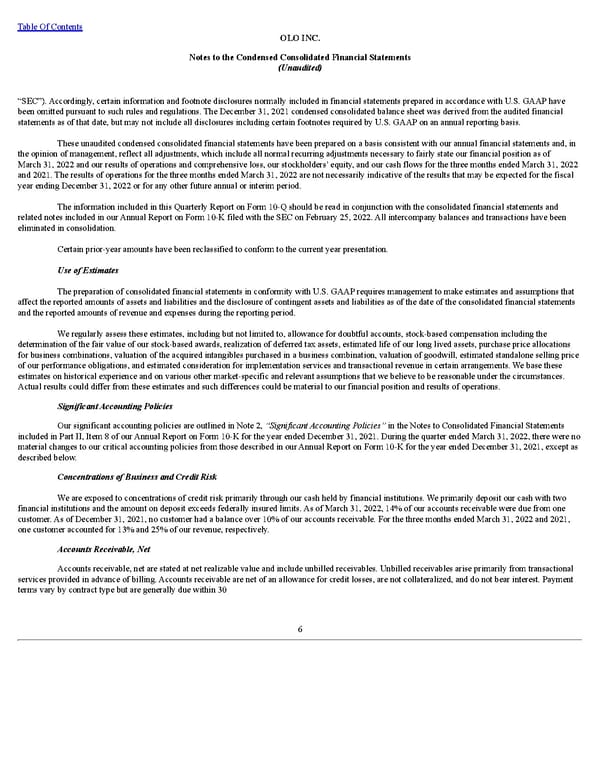Table Of Contents OLO INC. Notes to the Condensed Consolidated Financial Statements (Unaudited) “SEC”). Accordingly, certain information and footnote disclosures normally included in financial statements prepared in accordance with U.S. GAAP have been omitted pursuant to such rules and regulations. The December 31, 2021 condensed consolidated balance sheet was derived from the audited financial statements as of that date, but may not include all disclosures including certain footnotes required by U.S. GAAP on an annual reporting basis. These unaudited condensed consolidated financial statements have been prepared on a basis consistent with our annual financial statements and, in the opinion of management, reflect all adjustments, which include all normal recurring adjustments necessary to fairly state our financial position as of March 31, 2022 and our results of operations and comprehensive loss, our stockholders’ equity, and our cash flows for the three months ended March 31, 2022 and 2021. The results of operations for the three months ended March 31, 2022 are not necessarily indicative of the results that may be expected for the fiscal year ending December 31, 2022 or for any other future annual or interim period. The information included in this Quarterly Report on Form 10-Q should be read in conjunction with the consolidated financial statements and related notes included in our Annual Report on Form 10-K filed with the SEC on February 25, 2022. All intercompany balances and transactions have been eliminated in consolidation. Certain prior-year amounts have been reclassified to conform to the current year presentation. Use of Estimates The preparation of consolidated financial statements in conformity with U.S. GAAP requires management to make estimates and assumptions that affect the reported amounts of assets and liabilities and the disclosure of contingent assets and liabilities as of the date of the consolidated financial statements and the reported amounts of revenue and expenses during the reporting period. We regularly assess these estimates, including but not limited to, allowance for doubtful accounts, stock-based compensation including the determination of the fair value of our stock-based awards, realization of deferred tax assets, estimated life of our long lived assets, purchase price allocations for business combinations, valuation of the acquired intangibles purchased in a business combination, valuation of goodwill, estimated standalone selling price of our performance obligations, and estimated consideration for implementation services and transactional revenue in certain arrangements. We base these estimates on historical experience and on various other market-specific and relevant assumptions that we believe to be reasonable under the circumstances. Actual results could differ from these estimates and such differences could be material to our financial position and results of operations. Significant Accounting Policies Our significant accounting policies are outlined in Note 2, “Significant Accounting Policies” in the Notes to Consolidated Financial Statements included in Part II, Item 8 of our Annual Report on Form 10-K for the year ended December 31, 2021. During the quarter ended March 31, 2022, there were no material changes to our critical accounting policies from those described in our Annual Report on Form 10-K for the year ended December 31, 2021, except as described below. Concentrations of Business and Credit Risk We are exposed to concentrations of credit risk primarily through our cash held by financial institutions. We primarily deposit our cash with two financial institutions and the amount on deposit exceeds federally insured limits. As of March 31, 2022, 14% of our accounts receivable were due from one customer. As of December 31, 2021, no customer had a balance over 10% of our accounts receivable. For the three months ended March 31, 2022 and 2021, one customer accounted for 13% and 25% of our revenue, respectively. Accounts Receivable, Net Accounts receivable, net are stated at net realizable value and include unbilled receivables. Unbilled receivables arise primarily from transactional services provided in advance of billing. Accounts receivable are net of an allowance for credit losses, are not collateralized, and do not bear interest. Payment terms vary by contract type but are generally due within 30 6
 Q1 2022 10Q Page 9 Page 11
Q1 2022 10Q Page 9 Page 11